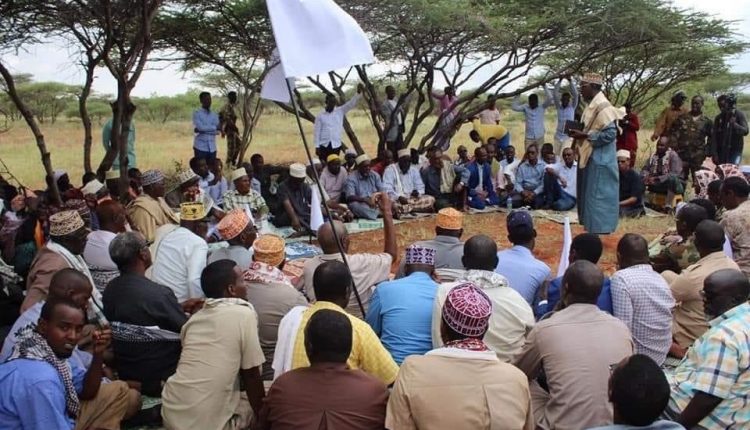Ahmed Jeeyte
It was 1991 when the Somali government collapsed, and clan-based warfare broke out throughout the country. Balanballe was the hotspot of the fight. As older adults say, there was a time when Balanballe and its surroundings were in bloodshed. The Ceyr-Ayaanle subclan and the Marehan-Reer Diini subclan mass killed each other. In those battles, thousands of people were killed, women and children fled and suffered, and some died of hunger and thirst; no one won. Only mothers became widows, and children became orphans. The fight between those neighboring clans was not started in 1991; it had existed for centuries. My grandfather’s eldest son ( a Reer-Diini) was killed in the 40s, for Aano-qabiil, by Ceyr sub-clan.
As I spent most of my life in the Balanbelle district, which is where I call my native home as it’s the city where my great-grandparents are buried, and my relatives used to live there generations ago, I learned from the older adults about their bad reflection, the worst time they endured, and what they experienced horrific action, bloodshed, and indiscriminate killing. At the same time, the killer is driven by the clan mindset, contrary, as they are not willing to forgive when someone against them enters their hands. Bad story!
That is why the majority of Balanballe’s residents are orphans or have lost a close relative; they do not believe that their deaths were due to illness, an accident, or a heart attack, but instead, that is Aano-Qabiil, a long-standing issue in the area, same as the other side Guricel.
In 1996, a peace initiative was made. From the ground up, elders from Guricel and Balanballe solved the conflict after realizing no one had won; this agreement brought relief and has lasted since 2005, where people from Guricel and Balanballe have lived together, exchanged trade, and are not afraid of each other. As I grew up in Balanballe, Ceyr business people came to Balanballe to buy camels and goats. It can be argued they were better at business than Marehan in Balanballe. This is why Balanballe was booming when the city was diverse, and people from Ceyr, Dir, and Marehan lived together.
It was 2005 when the peace agreement was broken, and fighting resumed. The Guricel and Balanballe clans had been fighting since then, and hundreds of people had been killed as they had been hunting each other. The fight always happens in rural areas where two groups come together for shelter in a place that receives rain, but everyone has their gun and is vigilant. Since then, no one from Guricel, especially from the Ceyr Ayanle sub-clan and the Marehan Reer Diini sub-clan, has been living without constant fear; they expect to be killed or have to kill. Guns and bullets become part of life’s essentials.
There were many attempts at peace talks, but they could not have been productive because the initiatives were not from those fighting, and the discussions did not reflect what was going on underground. Politicians and elders came together, took pictures, released press, agreed on terms, sent the invoices to the donors, and ended up with nothing because those fighting were not engaged, the root cause was not discussed, and every time an NGO got involved in the peace process, it just wasted time and money.
Now on, elders from both sides met on March 13, 2023, facilitated under Galmudug’s ministry of interior, federal affairs and reconciliation under Minister Abdi Mohamed Jama (Abdi Waayel), sat to talk about peace and signed an agreement to stop fighting and take more steps toward peace and the neighborhood. Rumors said that donors funded the project. People were disappointed about how these talks could be productive as long as the real cause and the right people were not engaged, disputed zones needed to be discussed, and the necessary agreement to come from the hearts of those fighting yet uninvolved.



Ceyr-Ayaanle and Marehan-reer Diini have long neighborhoods, inter-marriages, and strong bonds among relatives. For example, my biological aunt’s children are Reer Ayaanle; she currently resides in Balanbale; because of the clan conflict, her male children could not visit her; Clan separated a mother and her beloved children!
Baanballe and Guricel can reach a solution and everlasting peace. It is only when they are willing to and realize that killing each other brings nothing and no one wins. without involving any NGO or anyone funding it but by selling their camels and goats to support the peace talks.

Educated people and religious leaders should take their roles to stop the fighting between brotherhood clans, build trust, and find a way of living together. The space is enough that you may see hundreds of kilometers where no one resides.
The disputed areas are along the Ethiopian border; it involves both governments, Somalia and Ethiopia, in taking their roles, as the people are their people and are responsible for them. It is time to stop more children from being orphaned, no more mothers from being widowed, and no more fathers from losing their beloved children.
Ahmed Jeeyte is a public health practitioner and anesthetist. He is also a blogger who is passionate about medical and societal issues. He is on twitter https://twitter.com/axmedjeeyte and his blog is axmedjeyte.wordpress.com/
You too can also feature your writings on The Daily Jubba, if you meet the submission requirements on https://bit.ly/3SlMYfz by sending an email to [email protected]




